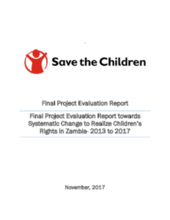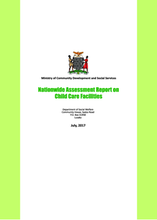childrens_living_arrangement
children_living_without_bio
Displaying 61 - 70 of 155
The consultancy will support the Department of Social Welfare through the Alternative Care Technical Working Group to document and compile information for the development of a draft strategy with implementation plan for the National Child Care Reform based on the current legal frameworks, Government’s vision for Child Care Reform, and on-going efforts (by Civil Society Partners and Cooperation Partners) to strengthen Child Care systems, including Alternative Care and Reintegration for children into family-based care in Zambia.
UNICEF is seeking a Chief of Child Protection in Zambia.
This report presents the preliminary findings from an ongoing project undertaken by 4Children that seeks to identify key opportunities to incorporate violence prevention and response interventions within priority PEPFAR Program Areas at clinical and community levels.
This column briefly explains child abandonment and the use of childcare homes for abandoned children in the Zambian context. The author notes that formal foster care is not a popular mode of alternative care in Zambia and that awareness-raising would help to increase its use in the country.
The Government of Zambia is piloting a Children First Software (CFS) application "that will provide a database of the vulnerable people in the country in order for them to receive support from their households as opposed to being institutionalised in centers," according to this article from the Lusaka Times.
The purpose of this endline evaluation is to assess the CRG, CP and HIV&AIDS achievements against the project goal and outputs.
Save the Children is recruiting for a consultant to review and finalize Zambia's National Implementation Plan to strengthen the Social Service Workforce.
This report is based on findings the Nationwide Assessment of all Child Care Facilities (CCFs) in Zambia, which aimed to gather evidence for the purpose of updating baseline information pertaining to the condition of all Child Care Facilities (CCFs) in Zambia; in line with the Minimum Standards of Care for Child Care Facilities (MSC), United Nations Convention on the Rights of the Child (UNCRC) as well as the UN Guidelines for the Alternative Care of Children.
This working paper assesses the performance of local and community-based structures in Kenya and Zambia in delivering the government social protection systems that they are tasked to support.
Article from The Guardian’s Social Care Network recognizing World Social Work Day and the needs of vulnerable children in Zambia.






